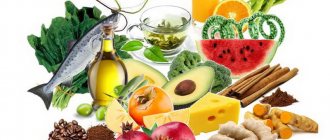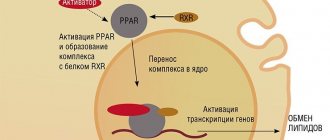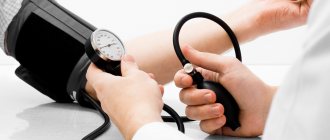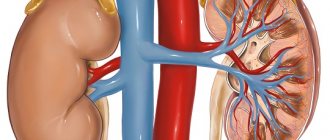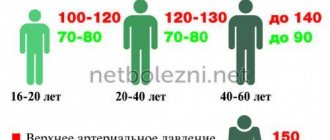The question of how to increase lower pressure without increasing upper pressure is often asked by patients to doctors. There is no definite answer to this, since a decrease in diastolic pressure can be based on a variety of reasons.
Low blood pressure, although an unpleasant condition, is rarely associated with severe pathology
Blood pressure is the pressure that blood exerts on the walls of the arteries. This important hemodynamic indicator includes three parameters:
- Systolic (upper, cardiac) pressure. At the moment of systole (contraction), the heart pushes a certain portion of blood into the aorta, which, as it moves through the arterial vessels, affects their walls. The strength of this effect is called systolic pressure.
- Diastolic (lower, renal) pressure. As blood moves, it experiences a certain resistance from the walls of blood vessels. The more elastic the vessels, the less pronounced this resistance, the faster the myocardium relaxes and the lower the diastolic pressure. The tone of blood vessels is greatly influenced by the biologically active substance synthesized by the kidneys - renin. And therefore the second value of blood pressure is sometimes called renal.
- Pulse pressure. It is the difference between upper and lower pressure, expressed in the same way as systolic and diastolic pressure - in millimeters of mercury (mmHg).
In clinical practice, an isolated decrease in diastolic pressure is observed extremely rarely, in no more than 2-3% of cases, and in the remaining 97-98%, hypotension is caused by a simultaneous decrease in both upper and lower pressure.
What blood pressure is considered normal?
The result of measuring pressure is two digits. The first is systolic pressure (at the moment when the heart contracts and pushes blood into the arteries). The second number is diastolic pressure (it is minimal and corresponds to the moment when the heart is relaxed). The absolute norm is considered to be 120/80 mmHg. Art., but for each person its own meaning will be normal. The individual norm depends on many factors, for example, weight and age. Also, stress, recent consumption of coffee or large amounts of liquid, overwork, physical activity, and other factors may affect the measurement results (Fig. 1).
Figure 1. What pressure is considered elevated. Source: MedPortal
Low blood pressure is considered to be below 90/60 mmHg. Art., elevated - if the values rise above 140/90 mm Hg. Art. These conditions manifest themselves in different ways.
Hypotension (low blood pressure) may cause the following symptoms:
- dizziness;
- nausea;
- loss of consciousness;
- weakness, fatigue;
- decreased concentration;
- deterioration of vision (everything becomes faded, blurry).
Hypertension (high blood pressure) may have the following symptoms:
- headaches, pain behind the sternum, in the heart area;
- shortness of breath (especially during physical exertion);
- dizziness;
- nosebleeds;
- nausea, vomiting.
Important! With both hypertension and hypotension, there may be no symptoms for a long time.
Therefore, it is better to periodically monitor your blood pressure by measuring it with a tonometer.
Diagnostic procedures
To normalize blood pressure, it is important to identify the reasons for its decrease. The approach to diagnosing arterial hypotension is complex. First of all, the doctor needs to assess the blood pressure level. Daily monitoring is best suited for these purposes. The procedure helps to identify how pressure readings change during the day. A technique for measuring blood pressure three times with an interval of 3-5 minutes is also used.
To choose treatment, you need to determine whether a decrease in lower pressure is an independent disease or a symptom of another disease. The patient is prescribed laboratory tests for hormones, electrolytes, glucose and other indicators. Among the hardware methods for diagnosis, electroencephalography, ECG, and orthostatic test are used.
A person with chronic arterial hypotension needs to consult a neurologist, cardiologist, or endocrinologist.
How do foods affect blood pressure?
Blood pressure is affected by both the composition of a person's diet and their eating habits, including how often they eat, how large their portions are, and how much fluid they drink. A healthy, balanced diet is one of the conditions for maintaining a healthy cardiovascular system, normal heart function and optimal blood counts. All this is directly related to blood pressure values.
What foods increase blood pressure?
There are a number of food products that increase the tone of the walls of blood vessels, the volume of fluid (and blood pumped), and also compensate for the deficiency of vitamins associated with hypotension.
Blood pressure increases when you eat the following foods:
- Salt, additives, seasonings containing sodium: retain fluid, increasing its volume in the body, increasing the volume of blood pumped. Salt intake should not be too high even with hypotension. WHO recommends consuming no more than 5 g of salt daily (1 teaspoon).
- Products containing caffeine: coffee, green tea, cocoa, strong sweet tea tone up and increase heart rate.
- High-calorie dishes. Baked goods, meat products, cheese, sweets, and high-fat dairy products provoke an increase in blood sugar, which causes blood pressure to rise. It is important for people with hypotension to eat foods that are nutritious enough, but they need to be careful that they are not excessively high in calories or contain too many carbohydrates or saturated fats.
- Products containing vitamins C, B12, E. With a deficiency of these vitamins, anemia develops, which is associated with the appearance of hypotension. By normalizing their consumption, you can reduce its manifestations. Citrus fruits, parsley, and red bell peppers contain a lot of vitamin C. Vitamin B12 is found in eggs, meat, and dairy products. Vegetable oil, avocados, and nuts contain a lot of vitamin E.
Important! Some foods prohibited for hypertensive patients can increase blood pressure: fatty, fried, too spicy foods, but using them to cope with hypotension is not recommended. Such food increases cholesterol levels in the blood, has a bad effect on the digestive system, and can cause additional health problems.
Foods that sharply increase blood pressure
Hypotension can make a person feel unwell, and it is important to know what to eat to raise blood pressure quickly. The following will help you feel better:
- black coffee;
- strong black tea;
- bitter chocolate;
- salty foods (this could be salted cheese, pickled vegetables, salted fish);
- prunes, dried apricots or other dried fruits;
- pomegranate juice;
- honey.
These products should only be used if it is known for sure that poor health is caused by hypotension. You can verify this by measuring your blood pressure. If symptoms associated with hypotension appear frequently, you should consult a doctor (general practitioner or cardiologist) and follow his recommendations.
Coffee and chocolate contribute to a rapid increase in blood pressure. Photo: nanka-photo / Depositphotos
What foods increase blood pressure during pregnancy?
In the first half of pregnancy, against the background of hormonal changes, blood pressure may decrease due to a decrease in the tone of the walls of blood vessels. This is normal, but if you experience symptoms associated with hypotension, you should inform your doctor. Blood pressure levels should return to normal after childbirth. If it becomes low during pregnancy, you need to make sure that this is not caused by anemia (for this, a blood test is taken).
To increase blood pressure during pregnancy, only certain foods can be used: chocolate, tea, pomegranate juice. Even they are not advisable to consume in large quantities so that the pressure does not become too high. This can be dangerous. It is also undesirable to increase the consumption of water or coffee (this may create additional stress on the kidneys), spicy, fatty, salty or too high-calorie foods. It is better to consult with your doctor and get nutritional recommendations from him, taking into account your general health, the duration of your pregnancy, and the characteristics of its course.
During pregnancy, you should be more careful when choosing your diet. Photo: Amina Filkins: Pexels
What foods should you not eat if you have high blood pressure?
Some foods can not only normalize blood pressure, but also increase it excessively. Eating these foods may be dangerous if a person already has hypertension. In this case, follow a special diet, excluding or limiting the consumption of the following foods:
- salt, seasonings, food additives containing sodium;
- strong tea, coffee containing caffeine;
- fatty, fried, spicy foods;
- pickles and canned foods;
- smoked meats;
- baked goods, sweets;
- fast food;
- sweet carbonated drinks;
- ready-made sauces, seasonings, flavor enhancers, and other additives that may contain sodium;
- frozen semi-finished products: pizza, dumplings and other similar dishes (may contain a lot of sugar, sodium, saturated fat to preserve taste);
- alcohol.
To prevent excessive stress on the heart and the appearance of essential hypertension, you need to adhere to a healthy, balanced diet in the same way as when preventing hypotension. Both hypertensive and hypotensive patients are equally benefited from fresh vegetables, nuts, herbs, fruits, whole grains, lean meat, poultry and fish. If your blood pressure is high, you need to eat more foods containing potassium, magnesium, and calcium. Bananas, beans, spinach, and sunflower seeds are especially useful.
Medicinal correction at home
An isolated decrease in diastolic reading occurs in a maximum of 10% of cases. In the remaining 90%, this is a combined change in the upper and lower levels, therefore, when prescribing drugs that promote the growth of DBP, one cannot ignore the level of systolic pressure.
For example, caffeine-containing drugs (Citramon, Pentalgin-N, Caffeine, Farmadol) will easily raise the diastolic reading, but if diastolic hypotension is combined with systolic hypertension, a crisis may occur, since caffeine will raise the already high systolic pressure.
Therefore, doctors prefer to prescribe beta blockers to increase low lower pressure: Coronal, Concor, Micardis, Telmisartan, Losartan or calcium antagonists: Isoptin, Verapamil, Finoptin, Diacordin. They additionally exhibit antiarrhythmic properties, so their self-prescription is unacceptable. A complete clinical and laboratory examination is required.
The drugs are prescribed in individual dosages depending on the general condition of the patient and his age. This is especially important for the elderly or those people who suffer from diseases of the vegetative-vascular system, heart, and kidneys.
In emergency cases, when there is a critical decrease in blood pressure, the following is administered: Prednisolone, Dexamethasone, Cordiamin, Dopamine, Mezaton.
Adaptogens
Low blood pressure can be raised using a large group of herbal or synthetic medicines that stimulate the human immune system and increase its ability to withstand negative influences. These include:
- ginseng – prevents stroke, improves immunity;
- basil is an excellent antioxidant, removes free radicals, toxins, rejuvenates the body, is used in Ayurscience, increases vascular tone, improves concentration, memory, and improves mood;
- ashwagandha (Chinese ginseng) – relieves anxiety by correcting cortisol in the bloodstream, exhibits antioxidant properties, rejuvenates cells, improves memory, prevents Alzheimer’s disease, alleviates menopausal symptoms;
- Eleutherococcus – stimulates the functioning of the heart and blood vessels, reduces sugar and cholesterol in the vascular bed;
- Schisandra is considered an excellent detoxifier and antioxidant;
- Rhodiola rosea – provides protection against stress, relieves fatigue;
- Astragalus is a legume, detoxifier, antioxidant, supervises the endocrine glands;
- licorice root – soothes, stimulates endurance, improves immunity;
- Schisandra (Chinese lemongrass) increases the resistance of internal organs to negative influences;
- reishi – the mushroom stimulates the immune system, prevents cardiovascular pathology;
- Peruvian maca – balances hormonal levels;
- rosemary relieves stress, improves the functioning of the cardiovascular and digestive systems.
Adaptogens play a significant role in raising lower low blood pressure, but are prescribed only on the recommendation of a doctor, since they do not have an isolated effect on DBP. Among synthetics we can note Pantocrin, Tonginal. These drugs are taken for no more than two weeks, since an overdose may lead to an increase in SBP with a hypertensive crisis.
- High lower pressure - causes and treatment with drugs and folk remedies
Vitamin and mineral complexes
A deficiency of minerals and vitamins can provoke a decrease in diastolic blood pressure. They are an alternative to a balanced diet. Use:
- Pikovit:
- Doppelhertz OMEGA 3;
- Complivit,
- Supradin;
- Vitrum;
- Centrum;
- Alphabet.
They are prescribed only by a doctor after a complete examination of the patient, since an overdose of calcium, potassium or magnesium, for example, can lead to serious neurological, renal, and cardiac disorders.
General recommendations for nutrition for hypotensive patients
With hypotension, it is important to adjust both the diet and diet. There are several eating habits that contribute to high blood pressure:
- Eat more often, but in small portions. This will ensure a constant supply of energy and high tone.
- Drink more water. When dehydrated, the volume of circulating blood decreases and blood pressure drops. If a person drinks enough water, the blood volume will be larger and the blood pressure will be higher. You need to additionally increase the volume of fluid you drink in hot weather and during physical activity.
- Don't skip meals. Such omissions can provoke overeating, which will cause blood pressure to drop.
- Reduce alcohol consumption. It causes dehydration and may worsen hypotension.
To improve your health with hypotension, you need to change your diet as follows:
- Get enough salt from food. Hypotonic people can eat dishes with added sea or table salt, as well as canned vegetables, cheeses, and salted fish. This will help retain fluid in the body and increase blood volume to increase blood pressure. In this case, total salt consumption should not exceed 5 g per day.
- Drink caffeinated drinks. It is better if it is natural coffee, black or green tea. The caffeine they contain causes heart rate to increase and blood pressure to rise. This effect is temporary. It should not be overused: if a person drinks a lot of coffee or tea, it can have a bad effect on heart health. In addition, over time, tolerance to caffeine may develop, and it will no longer provide a tonic effect.
- Get more vitamin B9 and B12 from foods. Hypotension may be associated with anemia caused by a deficiency of B vitamins. Hypotonic people need to eat more foods containing vitamin B12 (fish, chicken, eggs, low-fat dairy products) and B9 (broccoli, asparagus, lentils and chickpeas, liver).
- Control your carbohydrate intake. If your diet contains a lot of foods containing carbohydrates, this can have a bad effect on your heart condition and cause anemia. In addition, such foods are quickly digested, after which the pressure drops sharply. To reduce the symptoms of anemia, you need a balanced diet. It should not be overloaded with foods containing easily digestible carbohydrates (sweets, starchy foods, sweet vegetables, fruits and dried fruits, foods and drinks with added sugar).
In addition to nutrition, healthy habits such as good sleep and exercise are important (Figure 2).
Figure 2. General recommendations for hypotensive patients. Source: MedPortal
List of foods you can eat for hypotension
Hypotonic people can eat almost any food, but it is important that the diet remains balanced. The menu can include:
- fresh vegetables and salads made from them with added salt (but it is better to limit the overall use of salt and control it so that it does not provoke swelling);
- boiled or baked vegetables;
- cereals;
- fruits, dried fruits in limited quantities;
- meat, poultry, fish (preferably low-fat so that the level of cholesterol in the blood does not increase);
- cheeses, dairy, fermented milk products;
- bread, pastries, sweets (in limited quantities);
- chocolate;
- coffee and other caffeinated drinks;
- eggs;
- spices, hot seasonings (including ginger, pepper).
Additional dietary restrictions may apply that are not related to high or low blood pressure. To take them all into account, it is better to create a menu together with your therapist or nutritionist.
Is it possible to raise lower blood pressure in isolation?
There are no special medications to increase lower pressure in isolation, without raising the upper one. The relationship between DBP and SBP dictates the following tactics if it is necessary to reduce only the diastolic indicator:
- it is necessary to adequately assess the condition of the hypotensive patient;
- be sure to find the root cause (and it may be the most serious), that is, be completely examined in a clinic;
- select an individual treatment regimen based on the results of the data obtained.
Diastolic pressure characterizes the contractility of the myocardium. This means that we should look for the reason that violated it. Since lower pressure is called renal pressure, very often the root cause of diastolic hypotension is precisely a disruption in the functioning of the urinary system. Renal ischemia, chronic renal failure, nephritis of various origins. Only by eliminating the identified pathology can the lower pressure be brought back to normal without affecting the upper pressure.
Diastolic hypotension implies two development options: without any symptoms and with certain clinical symptoms. If there are no complaints, then no treatment is required (for tonometry readings up to 55 units). The presence of complaints with a large pulse difference (more than 60 units) deserves attention in the following cases:
- when SBP = 135-140 units and DBP is below 60, this is fraught with migraines, a feeling of chronic fatigue, and weakness, which indicates vascular disorders during normal myocardial function;
- if SBP is at the lower limit of normal (100-110), and DBP is significantly reduced (less than 40), this indicates that the joint work of the heart and blood vessels is pathologically impaired.
Sometimes persistent isolated diastolic hypotension indicates aortic valve insufficiency, which requires emergency assistance and surgical intervention. A simultaneous decrease in upper and lower pressure is a consequence of hormonal imbalance or VSD.
Folk remedies
The following folk remedies will help bring your heart rhythm back to normal without increasing your upper blood pressure:
- Cornflower infusion. Cornflower flowers, bearberry, crushed licorice root in a ratio of 1:5:2, 20 g of the mixture per glass of boiling water, leave for 8 hours, drink on an empty stomach, a tablespoon three times a day, for a month.
- Sea buckthorn infusion. Fresh or dry berries - 50 g, add a spoonful of tansy, yarrow, 2 spoons of immortelle, pour everything with a liter of boiling water, leave for an hour, drink a glass, a couple of times a day, course from 14 to 45 days depending on the effect (you can add immortelle) .
- Infusion of prickly steelweed. Stalnik is practically the only natural remedy that raises lower blood pressure in isolation; it is indicated for chronic diastolic hypotension: mix a teaspoon of stalnik and tansy (tonifies blood vessels), pour a glass of boiling water, leave for half an hour, divide into two doses, take before meals, course - two weeks (you can add immortelle)
You can use ready-made pharmacy tinctures of herbal adaptogens.
Diet
Walnuts with milk.
You can increase low blood pressure at home with a diet (fasting is excluded). A balanced diet involves inclusion in the daily menu:
- loaves with bran;
- rye bread;
- jacket potatoes;
- celery in all types;
- cabbage of different varieties;
- legumes;
- nuts;
- grapes;
- garlic;
- tea with lemon;
- chocolate;
- carrot, beet juice;
- dairy products.
It is important to ensure the supply of the required amount of fiber, iodine, and salt. A useful product for lowering blood pressure is seaweed, as well as citrus fruits, especially grapefruit.
Fatty foods (lard, fatty meats, duck, chicken with skin, deep-fried dishes), cholesterol-rich foods (brains, liver, kidneys, other offal, sausages, sausages, raw smoked and boiled sausage), and onions are removed from the diet. Anything containing caffeine and alcohol is limited to a minimum.
There is a separate question about the use of alcoholic beverages. Indeed, dry red wine or cognac can cope with the problem once. But (!) alcohol abuse will lead to neurological and cardiovascular disorders, which will only worsen hypotension and provoke its progression.
Alcohol standards for low blood pressure
| Drink | Norm for women | Norm for men |
| Red dry | 120 ml | 150 ml |
| White dry | 100 ml | 120 ml |
| Cognac | 30 ml | 50-60 ml |
| Vodka | 30-40 ml | 50-70 ml |
Strong drinks have the ability to reduce sugar.
What not to do
When providing emergency assistance, there are a number of rules that cannot be broken:
- bending or other physical exercises are excluded, this can cause cerebral hypoxia and fainting;
- Do not give ammonia to sniff, it can cause a migraine attack;
- drugs that increase blood pressure are prohibited unless they have been previously agreed upon with the doctor;
- Alcohol is contraindicated, since ethyl alcohol dilates blood vessels and leads to an even greater drop in blood pressure;
Diastolic hypotension or low blood pressure can be asymptomatic for a long time, so a sharp drop in blood pressure is always unexpected, and therefore a priori requires knowledge of the basic rules of first aid.
Massage
It helps to tone blood vessels, but it must be done correctly. Acupressure is effective for hypotension, but it is better to entrust it to a professional, since the key to success is accurate knowledge of the location of the points.
Massage of the feet and head helps a lot. You can do this yourself. The earlobes are pulled down, and then lightly rubbed, moving to the head area. Everyone does the fingertips. Massage the area of the neck and back of the head in different directions from the spine.
It helps to increase lower pressure if you first rub your palms, and then put one on your forehead and the other on the back of your head and sit there for a few minutes until the feeling of pleasant warmth disappears. Then, you can rub your palms again, put one on your chest, the other on your forehead, and again for a few minutes of rest. You can rub your chest yourself in a clockwise circular motion, either decreasing or increasing the radius.
It’s a good idea to lightly pinch your eyebrows from the bridge of your nose to your temples.
The feet are rubbed until a feeling of warmth appears.
A super exercise for low lower pressure is “propping up the skies.” Sitting comfortably on a chair, you need to stretch your arms up, as if you were supporting the sky, and freeze in this state for half a minute. If it’s difficult, then rub your palms, clasp them, put them on the back of your head, and sit like that for half a minute.
Prevention or how to prevent a drop in DBP
Hypotension is the only variant of the disease when the common opinion that it occurs only when one does not care about one’s health coincides with the opinion of doctors. You can reduce the risk of pathology by following the simplest recommendations:
- a full eight-hour (no less) sleep;
- reasonable alternation of physical and mental stress;
- contrast shower in the morning;
- dosed sports activities;
- walks in the open air;
- preventive self-massage;
- atherogenic nutritional profile, balanced diet;
- normal drinking regime, especially on hot days.
And most importantly - regular monitoring of blood pressure, annual medical examination, and preventive examinations.


